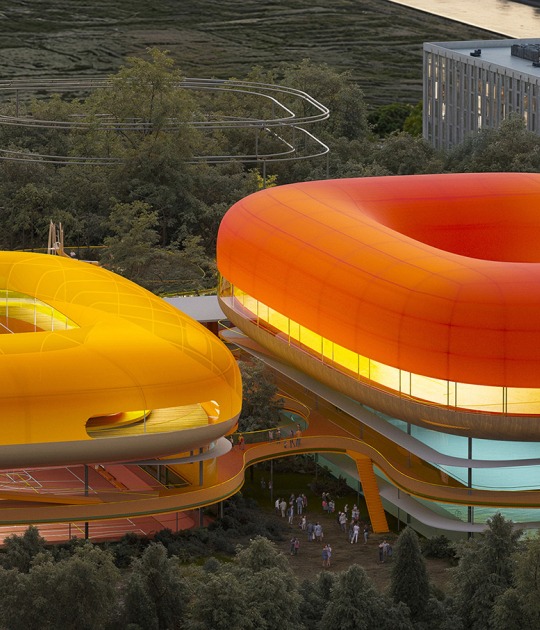However the level of the different proposals was so high that they deserve a closer look in order to discover what were the different concerns of our most renowned architects. Together, all the proposals will be exhibited at the Museo del Prado from the 1st December, but from Metalocus we bring them for you already, a few days in advance. In this occasion, it is the turn for the proposal of Nieto Sobejano, an intervention respectful with the historical heritage of the place, but that does not deny the modern world in which the extension is developed.
Descripción del proyecto por Nieto Sobejano
Our proposal for the old Royal Hall of the Buen Retiro Palace is the result of a reflection on the historical reality of the building - now it is very modified - and the temporality that implies all new action. The building that we know today is the result of multiple transformations since the nineteenth century that make it difficult to refer to an original historical moment. In the first place, we cannot properly speak of "one" building, but of the fragment of a much larger complex, the North Corridor of the Palace that survived the course of time, a longitudinal structure articulating two large open spaces, Main Square and Big Plaza.
The Royal Hall was a symbolic heart of the group in addition to the church of 'Los Jerónimos', the manor house and the disappeared Coliseum, buildings that stood out in the extensive reticule formed by the recreation and rest royal palace until its destruction in the Napoleonic invasion. When a fragment is separated from the whole, it seems difficult to grant it protagonist category, as an isolated architectural body. But that contradiction is what time has bequeathed us: the present building appears as an autonomous volume, disconnected from its surroundings in its North facade because of the base that responds to the unevenness by the important topographic modification which was carried out. It is now, when becoming part of the campus of the Prado Museum, that paradoxically, this solitary body will once again find a shared sense, in this case with the Juan de Villanueva's building, the expansion of Los Jerónimos and the manor house. The horizontal platform - which from the seventeenth century to the end of the nineteenth linked the two disappeared squares - will mark the level of the new place of access to the museum.
The elimination of the different bodies attached to the South facade over the years, is a fundamental condition that guides the subsequent project decisions. A new volume is separated from the three façade panels making visible the hitherto hidden southern façade of the historic Royal Hall and generating a covered outdoor space that connects physically and visually the access from the square in front of the street Felipe IV with the Terrace to the North. The public entrance takes place at the point where the street's height is closer to the zocalo's one, which implies a change in the axis of the building's access - a conscious decision that shifts the center of gravity thereof towards the East.
The mansard roof added the twentieth century, introduced a notable alteration and distortion of the volume that originally had the austere palace of the Austrias. Its replacement by a longitudinal covering to two waters will allow to recover adequate proportions in relation to the facades, the height of cornice and the spiers on the corner towers. The reduction of the exhibition space under cover that implies this action is compensated with the first and second plants new galleries which are incorporated in the new enlargement.
In the semi-basement floor are located the loading and unloading areas, warehouses, service areas, facilities, and underground communication with the Casón building. The ground floor is mainly intended for areas of public use such as the reception hall, cafe-restaurant, shop and access to the exhibition area through the 19th-century Honor Staircase to be restored, or through the new vertical comunication core located at the eastern end of the building. The first floor, protagonist of the central space that gives name to the building, will maintain the arrangement as a sequence generated by three large rooms, recovering a balcony that evokes the one that was lost according to the descriptions of the original building. Finally the attic floor, is entirely dedicated to showrooms.
The new facade of the museum extension will have an enclosure formed by panels of molten aluminum. Its vertical rhythm, based on the proportions of the gaps given by the historical building, is only altered in two points. On the one hand, a large window in the first floor gallery overlooks the urban axis of Moreto Street, marked by the monument to Queen Maria Cristina. On the other hand, in its eastern end, the facade panels are made foldable, being able to open or close in various positions to signal the new public access to the museum. As if it were a contemporary triptych, the unexpected support of exhibitions and activities will also symbolically transform the new image of the old Buen Retiro Palace and its incorporation into the Prado Museum. It will act as a foyer or lantern open to the sky, forming a public meeting space. The intervention in the old Royal Hall will appear in the Alfonso XII neighbourhood as a result of both the interpretation of the building's own history, and the incorporation of new architectures that emerge from the emulation of that one: an always unfinished process of transformation that reflect the Dialogue between memory and action.







































